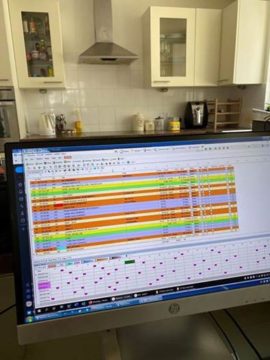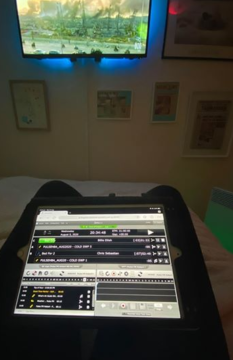Why choose between working from home (WFH) and going to the station?
 The 2020 health crisis has affected the way we all work and, after the initial shock to the system, more and more workers are discovering the benefits of working from home. But what comes next as lockdowns creak open and a ‘WFH’ lifestyle increasingly feels like your own personal Groundhog Day?
The 2020 health crisis has affected the way we all work and, after the initial shock to the system, more and more workers are discovering the benefits of working from home. But what comes next as lockdowns creak open and a ‘WFH’ lifestyle increasingly feels like your own personal Groundhog Day?
The greatest advantage of working from home centers around ‘freedom’. The freedom to sculpt your day around what you want to do, and when you want to do it, means that workers are always operating at peak intent. Don’t feel up to tackling that spreadsheet? Do something creative and fun instead. All out of amazing new ideas? Maybe it’s time to take care of those invoices after all.
When you work at home, there are fewer interruptions from bosses or distractions from work colleagues eager to waste their day. And by eliminating commutes, going out to buy lunch (or even change out of your pajamas), there’s more time to get more done. Data from time tracking tool RescueTime, shows that home workers enjoy a 4% increase in core work and an 18% decrease in time spent on communication when compared to office workers.
Over a year, that delivers up to 58 more hours of work from nowhere. And with the US Census Bureau finding that the average American commute is now 27 minutes per journey that’s almost an hour that home workers are (sometimes entirely) adding to their workday.
But the world of WFH isn’t all rosy. With the forces that create our work/life balance removed, the danger is that some workers are now working too hard and never actually escaping work.
Networker NordVPN reports that ‘wake-up times’ may indeed be later but ‘peak email’ is now an hour earlier. Similarly VPN Surfshark has seen spikes in usage from midnight to 3am that simply didn’t exist before the current crisis. And aside from the health implications – both physical and mental – you do have to question the quality of anything being produced at 3am.
 It’s therefore not surprising that in a survey of their users, market-leading sales tool Salesforce found that 64% of workers said that they want to spend ‘at least some’ time in the workplace. Similarly a recent survey published by UK serviced office supplier Office Space In Town found that just 5% of employees want to remote work on a full-time basis.
It’s therefore not surprising that in a survey of their users, market-leading sales tool Salesforce found that 64% of workers said that they want to spend ‘at least some’ time in the workplace. Similarly a recent survey published by UK serviced office supplier Office Space In Town found that just 5% of employees want to remote work on a full-time basis.
But this is only what freelancers and coffee shop warriors have known for years – getting away from daily life and securing a little productive ‘me time’ is only ever a good thing. Indeed, studies have shown that the uncontrolled ambient bustle of a coffee shop is more conducive to creativity versus the predictable, controllable environment of home.
These same desires have fueled the rise of co-working spaces with a report from Raconteur discovering that the basics of ‘a social and enjoyable atmosphere’, ‘interaction with others’, a sense of ‘community’ and ‘like-minded people’ leads workers to flee the easy life of the dining table boardroom and bedroom office in favor of a more conventional workspace entirely by choice.
It’s clear therefore that there’s a happy medium to be found, and with working from home and alongside colleagues in a workplace each having their pluses, can’t we just have both?
 Welcome to the ‘new, next level normal’, one that’s become known as ‘hybrid working’. It’s an approach that smartly cherry-picks the upsides from WFH and safe co-working, while dodging either’s downsides.
Welcome to the ‘new, next level normal’, one that’s become known as ‘hybrid working’. It’s an approach that smartly cherry-picks the upsides from WFH and safe co-working, while dodging either’s downsides.
A typical hybrid worker will therefore rise out of bed later and be more rested, yet start work earlier. They’ll manage their own workday, performing the tasks they feel most attuned to and they’ll spend more time with loved ones rather than being jostled with strangers on a frustrating commute.
They’ll work through lunch, yet gain greater job satisfaction as they get more done. They’ll be empowered by like-minded ‘hybrids’ and seek out company and collaboration in comfortable, safe, purpose-built workspaces free from the responsibility to own or manage them.
These hybrid workers will be inspired, learn new skills and then take that knowledge to wherever it can be best put to use. They can get change and influence when they want it and stability and predictability when they don’t. They’ll produce more quality work in less time, without any worries of burnout, boredom or burden. Hybrid delivers the dream of all the support from their big stack IT, their trusted team and corporate infrastructure, plus the new freedom that only comes from the time and space to work their own way.
So what are the requirements for going hybrid? Connectivity is, of course, key. Intent Group found that ‘Good Wi-Fi’ is the main requirement of 95% of co-workers. But it’s new smart software with mobile components that’s emerging as hybrid’s biggest enabler.
Software vendor RCS – the world’s biggest supplier of broadcast software – is a company that’s already used to delivering performance under pressure as its suite of Zetta, GSelector and Aquira software power the output of thousands of radio stations worldwide. What was devised as a way to more easily deliver outside broadcasts and to remotely back up content in case of outages, is at the core of freeing users as they go hybrid.
The RCS suite features ‘To Go’ mobile versions, enabling teams to collude on sequencing songs, putting together shows and even selling the ad slots in between, all from anywhere via an internet connection. And remote workers can get at their projects anywhere via Zetta Cloud, so when there’s the opportunity for safe co-working they can bring their projects – and the time spent apart – back together, delivering the best of all workplace worlds.
 RCS software gifts the power to create, perform and deliver rich entertainment that is now seamlessly powered by the passion, freedom and creativity of the people that use it. They’re typical of the new hybrid workers that are creating their best work while getting more done, with less interruption, friction and fuss.
RCS software gifts the power to create, perform and deliver rich entertainment that is now seamlessly powered by the passion, freedom and creativity of the people that use it. They’re typical of the new hybrid workers that are creating their best work while getting more done, with less interruption, friction and fuss.
The road ahead is increasingly looking like it’s reached a point of no return as, through the necessity of adversity, powerful tech has made good on its promises and finally delivered. It’s up to managers everywhere to use lockdown learnings and take the next steps towards a smarter, more flexible and more efficient workplace.